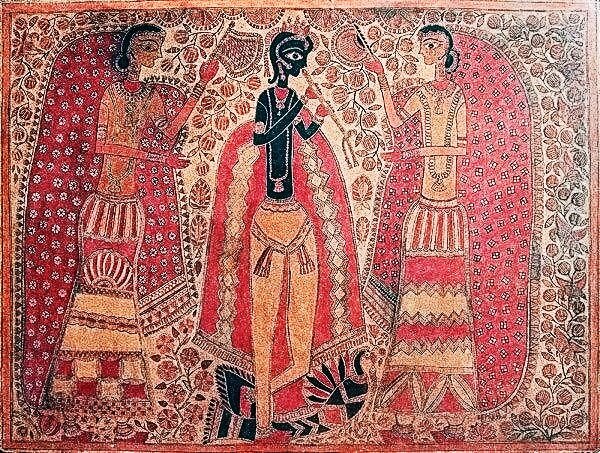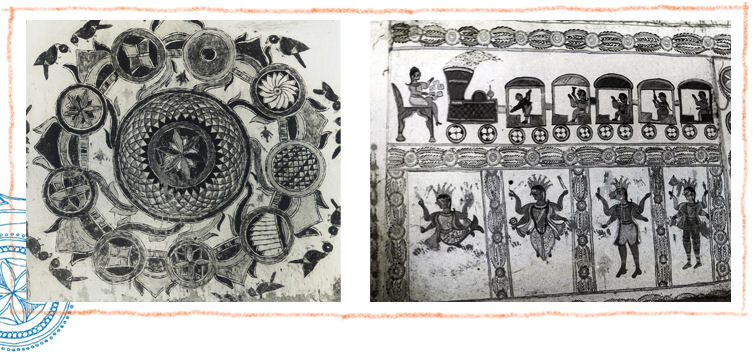Madhubani




Entire city of Mithila was decorated like a bride. Because today was the day when Mithila King Janak’s daughter Sita was getting married to Rama, the prince of Ayodhya. Sita, a charming young lady, the first daughter of Mithila, also came to be known as Maithili. She is the first woman who inspired the artform known as Madhubani paintings. The wedding of Sita and Rama was no ordinary affair. This was the wedding that everyone was talking about. Rama a handsome prince with big oval-shaped eyes and broad shoulders was a perfect match for the beautiful Sita and he had won her hand by demonstrating his strength by lifting a divine bow. As was the tradition thousands of years ago when this marriage took place and is still a tradition in many parts of India today, the groom’s family was going to stay for a few days for marriage in Janak’s house before departing to their native place. To celebrate this wedding, Janak asked artists in his town to decorate every wall in the city with colorful paintings and especially the marital chamber, known as “Kohbar Ghar”, where most of the wedding rituals for the wedding were going to take place. And thus came the Madhubani art form into existence. Painted on the walls of the marital chamber by women artists, these paintings are also known as Mithila paintings because of their association with Mithila, the city, and Maithili, the lady who was the reason behind these paintings.
Women artists continued the tradition of decorating the Kohbar Ghar with images of flowers, birds, sun, moon, deities and other motifs. They used simple tools such as twigs and brushes made of cotton and painted intricate designs with natural dyes and colors. Over time, this tradition of painting the walls also extended beyond marriage ceremonies to other festivals and special occasions. Many places in India and Nepal have a tradition of decorating the walls of their homes with hand-painted designs, but Madhubani art is unique because of the richness, details and the vibrant colors used in these paintings. But this beautiful art form, inspired by Sita’s wedding and practiced by women artists was completely unknown to the outside world and if it was not for a couple of natural disasters, it would still be confined to the walls of houses in Mithila.
The first natural disaster to play an important role in the evolution of Madhubani art was the Bihar earthquake in 1934 that destroyed many houses. William Archer, a British colonial officer, “discovered” the paintings on the interior walls of Mithila houses while he was inspecting the damage done by the earthquake. He was stunned by the beauty of the paintings and took several black and white pictures that were later published in the year 1949 in an India art journal, Marg. William Archer later became the South Asia Curator at London’s Victoria and Albert Museum and he found the Madhubani paintings to be in the same class as the work of western artists like Miro and Klee. But the art form, now known to a few intellectuals, still remained confined to the inner walls of Mithila houses and a mention or two in intellectual circles. It took a few more decades and a yet another disaster, but more importantly the initiative or a few more women, to bring it out in the world.
In the late 1960s, another natural disaster gripped the area. Because of a serious drought, the economy in the region became very poor. Pupul Jayakar, who was head of All India Handicrafts Board at the time and more importantly a good friend of Indira Gandhi, the first women prime minister of India, had a vision of transforming lives using art. She convinced the Government of India to champion a program that handed out papers and colors to women of Mithila as an income generating project. Women would bring the Madhubani art from the walls of their houses to the paper and the sale of the art would provide a good source of income to the poorest of the poor women.
Art really has the power to transform not just lives but societies. Madhubani art, once confined to walls inside the houses, could go places when it was transferred to paper. With a rich visual cultural background and a tradition of using lines and colors to draw on walls, many women artists unleashed their talents and soon they were representing India on an international stage. Aside from generating family income, women gained respect and recognition because of Madhubani art. A few women artists such as Sita Devi, Jagdamba Devi, Ganga Devi, and Mahasundari Devi went on to win the prestigious Padma Shri award, the fourth highest civilian award given by the Government of India. Opportunities for travel, education and eventually internet expanded women’s consciousness and now they are able to able to play an even more fulfilling role in their societies. Madhubani designs have found their way into handicrafts, sarees, homeware, and even trains. No longer a “folk art”, Madhubani is now known as a “contemporary art” while still retaining its original charm and style.
Preserve Culture, a non-profit, non-political and non-religious organization is working on helping create awareness for our cultural heritage. One such project is sponsoring Madhubani art classes where anyone can learn to create this beautiful art. We hope you enjoy this art form by decorating the walls of your home with vibrant colors of Madhubani that will surely bring you closer to Mithila where it all started.
